Sylvia of the Museum of African Art 1977 South African Graphics
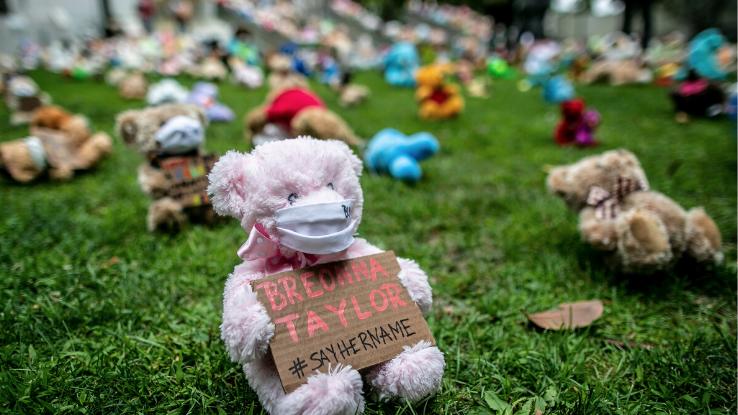
Without a doubt, the COVID-nineteen pandemic inverse the way audiences view fine art. From virtual tours and talks to meditative, educational livestreams, museums and other cultural institutions found unique ways to keep would-be guests engaged from the comfort of their living rooms. And although many of us developed serious cases of screen fatigue afterward sheltering in place and weathering regional lockdowns, when it came to experiencing alive music, it was hard to imagine a socially distanced twist on concerts or shows that felt both safety and wholly engaging.
Merely the shift we experienced during the pandemic hasn't stopped with how we feel art. The ways creatives make art and tell stories accept been — volition be — irrevocably altered as a consequence of the pandemic. While it might feel like it's "besides soon" to create art nigh the pandemic — near the loss and anxiety or even the glimmers of hope — it'south clear that art will surface, sooner or later on, that captures both the world as it was and the world as it is now. There is no "going back to normal" mail service-COVID-19 — and art will undoubtedly reflect that.
How Did Museums, Galleries and Art Spaces Adapt to Pandemic Safety Measures?
When it comes to social distancing, the Mona Lisa is a pro. Located at the Louvre Museum in Paris, Leonardo da Vinci's dearest Renaissance painting is displayed in a purpose-built, climate-controlled enclosure — complete with impenetrable drinking glass and several feet of space between its spot on the wall and the stanchion that holds legions of viewers back. On boilerplate, six million people view the Mona Lisa each yr, and while the painting is somewhat of an bibelot, large museums like the Louvre are inundated with throngs of visitors on a near-daily basis. Or, at least, that was true for these popular tourist sites before the novel coronavirus hit.
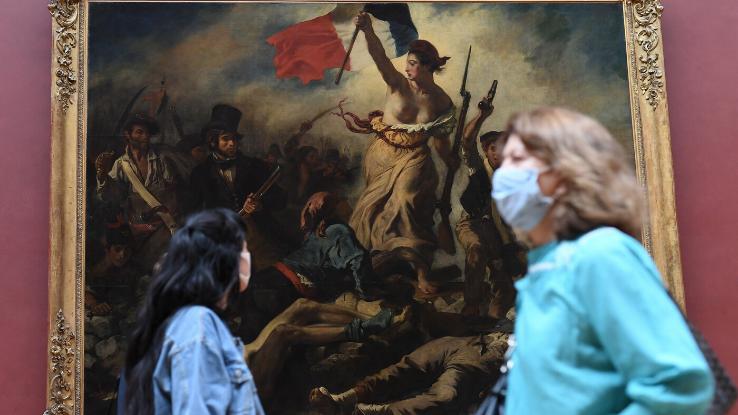
On July half-dozen, the Louvre ended its xvi-week closure, allowing masked folks to manufacturing plant near and take in works like Eugène Delacroix'southward Freedom Leading the People (higher up) from a distance. Unlike theaters, cinemas and concert halls, museums tend to be better equipped than other tourist hotspots to mitigate visitor contact and control crowds. It's non uncommon for institutions with popular exhibits to institute timed ticketing blocks or curb the number of guests that enter a gallery space at a fourth dimension, even earlier social distancing requirements were put into place. Those practices became fifty-fifty more important during reopening but earlier big-scale vaccine rollouts had begun taking place.
Why dauntless the pandemic to see the Mona Lisa and then? For many folks in the art world, including the full general director of Opera Memphis Ned Canty, going to a museum or art space was more than just something to do to break up the monotony of sheltering in place. "[W]due east will always desire to share that with someone next to us," Canty said. "Whether nosotros know that person or not, that increases the value of the experience for everyone… It is a bones human need that will non become away."
As the world's most-visited museum, the pre-COVID-19 Louvre welcomed 50,000 people a twenty-four hour period, on average. In the summer of 2020, the museum instituted mask and distancing requirements, an online-only reservation system and a one-way path through the edifice. Visitors could no longer meander from piece to piece, and, over the summertime, 30% of the Louvre remained closed. According to NPR, the Louvre anticipated 7,000 people on its first day back, and avid fans didn't let information technology down: The museum sold all 7,400 available tickets for the chiliad reopening.
While that number is nowhere near 50,000, it still felt like a large gathering of people, no matter the restrictions the museum had put in place. It was certainly large past COVID-xix standards, to say the to the lowest degree, which is probably why the Louvre shuttered again in tardily Oct in compliance with the French government'due south guidelines — and amid a spike in positive COVID-xix cases. Although the museum has since reopened, mask mandates and social distancing rules have remained, and only the outdoor eateries have been opened.
What Accept We Learned From the Fine art of Pandemics By?
In the mid-14th century, the Black Expiry, an epidemic of the bubonic plague that swept through Eurasia and North Africa, killed between 75 million and 200 million people. In response, Boccaccio penned The Decameron, a "man comedy" nearly people who flee Florence during the Black Death and continue their spirits upwardly past telling comedic, tragic and raunchy stories. It might take seemed foreign in your higher lit grade, just, now, in the face of COVID-19 memes and TikTok videos, maybe The Decameron'due south one-act-in-the-face up-of-despair perfectly captured the zeitgeist?
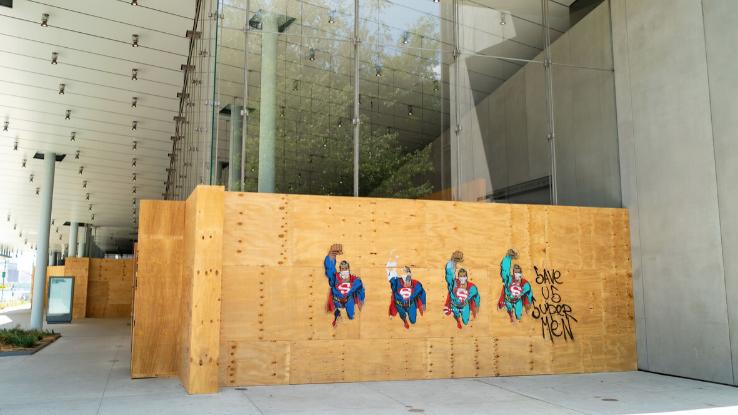
After, in the wake of the 1918 flu pandemic, creative person Edvard Munch painted Self Portrait Afterward the Spanish Flu. Not unlike the selfies taken past tired, despairing healthcare professionals and overwhelmed COVID-19 survivors, Munch'south self-portrait captured not only his jaundice but a sense of despair and nihilism. At a fourth dimension when folks were dealing with the era'south dual traumas — the end of Earth War I and 50 million deaths worldwide due to the 1918 flu pandemic — it'south no wonder the art world shifted so drastically.
With this in heed, it'due south clear that past public health crises accept shifted the aesthetics and intent of the work artists are moved to create. Not different in the early on 20th century, we're living through a time of staggering change. Not only have we had to debate with a wellness crisis, just in the Us, folks realized the power of protest in meaningful new ways by rallying behind the Black Lives Affair Move; the fight for the rights and sovereignty of Ethnic peoples; trans and queer rights movements; and the fight confronting climatic change.
Why Was It Of import to Foster Art Spaces Outside of Museums and Galleries During the Pandemic?
The AIDS Crisis of the 1980s and 1990s — augmented by the silence and inaction from President Reagan and the Centers for Illness Control and Prevention — devastated a generation, namely a generation of gay men, Blackness people, queer people of colour and sex workers. In add-on to fighting for their public health concerns to exist recognized in the midst of the HIV/AIDS epidemic, activists were besides fighting for human rights. Every bit such, myriad artists, including Keith Haring, Robert Mapplethorpe, Andres Serrano, David Wojnarowicz and Nan Goldin (only to name a few), lent their work and voices to bring visibility to what the authorities was ignoring.
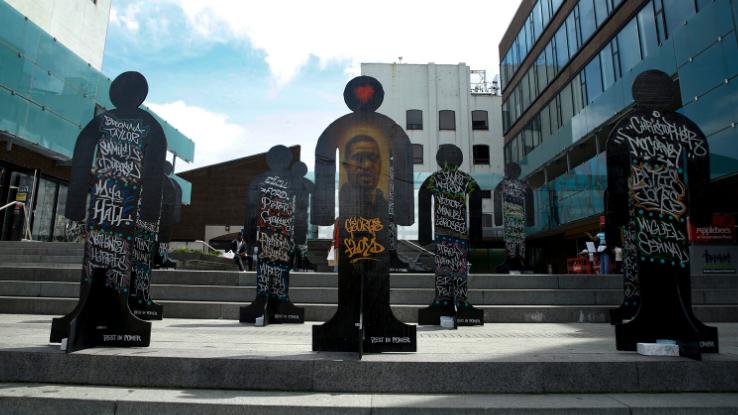
The intent behind these works varied: Some pieces were meant to document the epidemic, while others were meant to amplify silenced voices and underscore the humanity of folks fighting for their lives. The goal wasn't to make museum-approved works. Now, during a time of immense change and disruption, we tin can yet see important, era-defining works of art emerging all around usa.
In the wake of George Floyd'south murder and the first wave of Black Lives Matter Protests in 2020, artists across the country — and fifty-fifty the globe — took to the streets to create murals dedicated to Floyd, to Black activists and to promoting radical change. In parks and public spaces all beyond the earth, activists toppled statues and other monuments to racist and bigoted historical figures, making style for artists to immortalize new (and actual) heroes.
In add-on to street art, artists and art collectives seized the opportunity to capture the full general public's attention with other forms of protestation art. In Brooklyn, New York'south Bed-Stuy neighborhood, an anonymous grouping of artists installed a Blackness Lives Matter piece (above). In it, Blackness figures, covered in the names and images of Black men and women who have been murdered at the easily of law and considering of white supremacy, fill a Fulton Street plaza.
Beyond the country, in Los Angeles, Mae and Sydni Wynter designed the temporary installation, Conduct the Truth, at City Hall. The grassroots exhibition, made upwards of teddy bears holding Black Lives Matter signs and sporting face masks every bit acknowledgements of the COVID-19 pandemic, was meant to exist a "positive gateway for children to use their voices for change."
What'due south the State of Art and Museums At present?
From murals on the sides of buildings to installations in public spaces, these works of fine art are accessible to all — there'south no budgetary barrier to entry, and they're in open spaces, which allowed folks navigating the pandemic to nevertheless run into them and even so allows united states of america to enjoy them as fully vaccinated people have resumed pre-pandemic activities. This isn't a new mode of displaying or experiencing art past any means, but it certainly feels more than of import than ever. Museums have largely begun reopening their doors while maintaining safety measures, but, equally with many other COVID-xix protocols, things seem to vary state-past-state. This may remain truthful for the foreseeable futurity, and policies may vary from museum to museum.
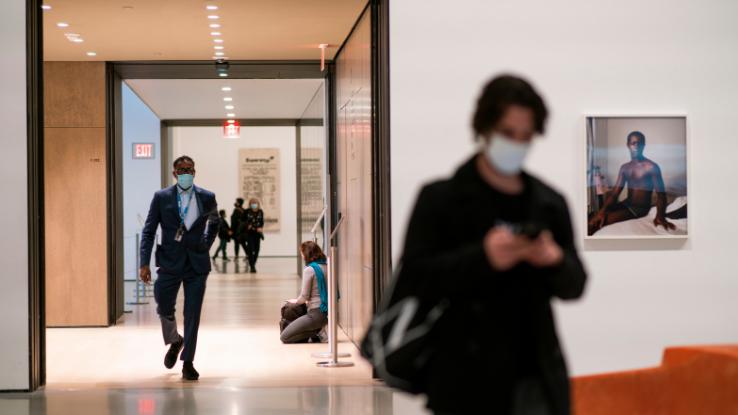
While museums may not be "essential" businesses or services, it'due south clear that in that location's a want for art, whether it's viewed in-person or most. In the same way information technology's difficult to conceptualize what sorts of mediums or imagery will dominate post-COVID-19 art, it'south hard to say what will happen to museums in the coming months. One affair is clear, however: The art fabricated now will be every bit revolutionary as this time in history.
Source: https://www.ask.com/culture/ask-answers-covid19-pandemic-impact-art-museums?utm_content=params%3Ao%3D740004%26ad%3DdirN%26qo%3DserpIndex